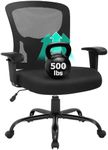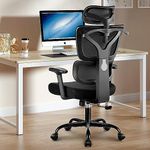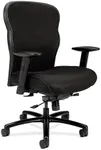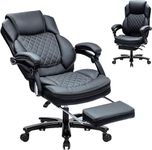Buying Guide for the Best Office Chair For Tall Person
Choosing the right office chair is essential for comfort, productivity, and long-term health, especially if you are taller than average. A chair that fits your body well can help prevent back pain, improve posture, and make long hours at your desk much more comfortable. When shopping for an office chair as a tall person, it's important to focus on features that accommodate your height and provide proper support. Understanding the key specifications will help you find a chair that suits your needs and keeps you comfortable throughout the workday.Seat Height RangeSeat height range refers to how high or low the chair can be adjusted from the floor. This is crucial for tall people because you need a chair that allows your feet to rest flat on the floor while keeping your knees at a comfortable angle. Standard chairs often have a maximum seat height that is too low for taller users. Look for chairs with a higher maximum seat height—typically, a range that goes up to 20 inches or more is better for tall individuals. If you are over 6 feet tall, you may need a chair that can go even higher. Always check the seat height range and compare it to the length of your legs to ensure a good fit.
Seat DepthSeat depth is the distance from the front of the seat to the backrest. For tall people, a deeper seat is important because it supports more of your thighs, which helps with comfort and circulation. Standard seat depths are usually around 16-18 inches, but taller users may need 19 inches or more. If the seat is too shallow, you may feel unsupported; if it's too deep, it can be uncomfortable for shorter periods. Ideally, you should be able to sit with your back against the backrest and have a few inches between the edge of the seat and the back of your knees.
Backrest Height and SupportThe backrest height determines how much of your back is supported. Tall people often need a higher backrest to support their upper back and shoulders. Some chairs offer adjustable backrests or headrests, which can be especially helpful. Look for a chair where the backrest reaches at least your shoulder blades, and consider one with a headrest if you want neck support. Proper backrest height helps maintain good posture and reduces strain on your spine.
Weight CapacityWeight capacity is the maximum weight the chair is designed to support safely. While this is important for everyone, taller people sometimes have a larger build and need a chair that can handle more weight. Most standard office chairs support up to 250 pounds, but there are chairs designed for higher capacities. Always check the weight rating to ensure the chair will be safe and durable for your use.
AdjustabilityAdjustability refers to how many parts of the chair can be customized to fit your body. This includes seat height, seat depth, armrest height and width, lumbar support, and tilt tension. The more adjustable a chair is, the easier it is to make it comfortable for your unique body shape. For tall people, being able to adjust the seat depth and armrests is especially important. Look for chairs that offer multiple adjustment options so you can fine-tune the fit.
Armrest Height and WidthArmrest height and width determine how well your arms are supported while you work. For tall people, armrests that are too low or too close together can cause discomfort. Adjustable armrests allow you to raise them to a comfortable height and move them outward if needed. This helps prevent shoulder and neck strain, especially during long periods of typing or using a mouse.


















